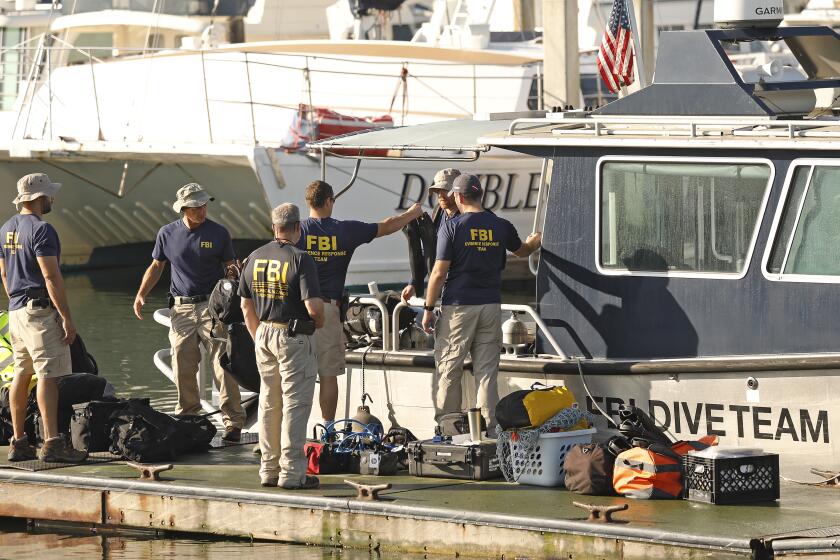34 people trapped on burning boat. The crew was asleep and unable to help, officials say

- Share via
PORT HUENEME — When fire ignited aboard the Conception in the predawn dark, none of the crew members was awake to alert the passengers sleeping below deck, even though federal law required that the charter boat have a night watchman, the National Transportation Safety Board said Thursday.
The crew members were sleeping in a berth behind the wheelhouse. By the time they woke and jumped down to the main deck, they found the galley and salon engulfed in flames. The horror was plain: The main bunk room where their 33 customers and a fellow crew member dozed lay directly below, in the belly of the boat. The only way out was through the inferno. No one made that escape.
Officials say they suspect the 34 people who died that morning succumbed to smoke inhalation. The maritime disaster on Labor Day just 20 yards off Santa Cruz Island was the worst in modern California history.
NTSB board member Jennifer Homendy said the purpose of having a night watch is to detect dangers such as fires early. With so many people tightly packed in a wooden vessel, at the whims of the ocean and wind, situations can turn dire in an instant.
U.S. Coast Guard officials said a watch person typically walks through the vessel and checks equipment throughout the night.
Stanley Payne, 79, whose wife’s sister was on board the Conception with several other relatives, took a long pause while he processed the news in the NTSB’s preliminary report.
A commercial diving boat caught fire near the shoreline of Santa Cruz Island, Calif., early Monday. Many aboard the boat were believed to be sleeping below deck when the fire broke out in the pre-dawn hours.
“We suspected that all along,” he said. “That’s a major breach of security…. If it’s possible, the captain at least ought to be held responsible.”
Officials are still trying to determine the cause of the fire, and on Thursday, they raised the remains of the Conception from the seafloor of Platts Harbor after a weeklong delay due to strong winds.
By late morning, a massive crane with yellow straps slowly lifted the vessel up the side of a barge. Much of the boat had been gutted, with only the hull and the lower berths remaining intact.
Investigators hope an examination of the boat will help pinpoint the source of the fire and reveal how it spread so rapidly.
“This is the most critical stage,” said Coast Guard Petty Officer 1st Class Mark Barney. He noted the importance of keeping what’s left of the boat intact for investigative purposes.
California Boat Fire: An emergency escape hatch is a center of investigation into Conception disaster. Some passengers say they were not aware of it. Others said they were.
The Conception is expected to be taken to a naval facility, where a team of investigators from the U.S. Bureau of Alcohol, Tobacco, Firearms and Explosives will examine its power, fuel and electrical systems, federal officials said.
The designer of the dive boat told The Times that he believed the fire began in the sleeping quarters with a lithium battery charger; crew members told investigators the blaze may have erupted at a charging station used by passengers in the galley.
Investigators from the FBI, the ATF and the Coast Guard had launched a criminal investigation by the weekend, searching the Santa Barbara Harbor office of the Conception’s operator, Truth Aquatics, on Monday, and inspecting two of the firm’s other charter boats.
The NTSB’s preliminary report provides the most clear narrative yet about what happened aboard the vessel that fateful morning: A crew member sleeping in the wheelhouse was awakened by a noise. When he got up to investigate, he saw a fire at the sun deck, rising up from the salon, and alerted four other crew members. They jumped onto the main deck — one man broke his leg in the process — and tried to get into the salon and galley, but the flames kept them back. Overwhelmed by smoke, the crew jumped overboard.
The probe is being led by the U.S. Coast Guard criminal investigative group under the oversight of the U.S. attorney’s office in Los Angeles.
According to the report, two crew members and the captain swam to the stern, reboarded the vessel, opened the hatch to the engine room and saw no fire. Access to the salon through doors near the stern was blocked by fire, so they launched a small skiff and picked up the remaining crew members in the water. They sought help from a fishing boat, the Grape Escape, that was anchored nearby.
The parents of one victim, Charles McIlvain, praised investigators for their early findings.
“The preliminary NTSB report has answered a very crucial question — ‘Was a night watchman posted?’ — and the answer was ‘No,’ which of course disturbs us greatly,” Kathleen and Clark McIlvain said in a statement to The Times. “Early detection may have made an incredible difference in [the] outcome.”
The Conception’s captain, Jerry Boylan, did not respond to a request for comment Thursday.
John McDevitt, a former assistant fire chief, accredited marine surveyor and chairman of a National Fire Protection Assn. committee on boat protection, highlighted the importance of functioning smoke alarms for overnight safety.
“There’s so much left to chance when you depend on a roving watchman,” McDevitt said. “You have the technology, the 50-year-old-plus technology, of a smoke alarm that would have even alerted the roving watchman right away if he wasn’t up and awake.”
The NTSB’s preliminary report mentions the presence of two smoke detectors in the boat’s bunk room. The report doesn’t specify whether they were working or whether there were detectors in other parts of the boat.
Douglas Schwartz, an attorney representing the owners of the Conception, said that based on “current evidence and testimonials,” he does not believe the fire was caused by the operator, the boat or the crew. He said crew members “acted heroically and did all in their power to try and save the lives of the passengers and their fellow crew member.”
Schwartz also said he disputes the NTSB’s assertion that the entire crew was asleep when the fire broke out. Schwartz told CNN he has “witness testimony that seems to contradict the notion that the entire crew was asleep.” The lawyer declined to answer The Times’ questions on the statement, but he told the Associated Press that a crew member “checked on and around the galley area” about 2:30 a.m. Sept. 2.
Investigators seek cause of deadly fire aboard California dive boat
“We all hope and anticipate new regulations will come as a result of the investigation,” Schwartz said. “We would ask whether safety agencies that have been aware of the dangers of lithium-ion batteries in other modes of transportation have considered applying this knowledge to the charter boating industry.”
On Wednesday, the Coast Guard issued a safety bulletin recommending that commercial boat operators nationwide review safety measures, make sure safety equipment is operational and reduce potential hazards from lithium batteries, power strips and extension cords.
Officials are also investigating whether passengers received appropriate safety instructions aboard the Conception.
The Times spoke to more than a dozen people who have recently been on Truth Aquatics boats. Although many remembered the crew as professional and conscientious about safety protocols, some said that the captain’s initial safety briefing was inadequate.
Officials have recovered the bodies of 33 people who died in a massive fire aboard the Conception. One person remains missing.
The boat’s design has also come under scrutiny, particularly over whether the escape hatch located in the bunk room provided an accessible route for people to leave the boat during an emergency. From the bunk room, there were two ways out to the deck: a staircase on one side and the emergency hatch on the other. Both led to the galley area.
The NTSB’s Homendy told The Times last week that she was “taken aback” by the size of the emergency hatch — which measures about 2 feet wide — when she toured the Vision, a sister vessel that is similar in size and layout to the Conception.
Investigators plan to examine regulations regarding vessels similar to the Conception that were built the same year and conduct similar operations; check early-warning and smoke-detection and alarm systems; evaluate evacuation routes and staff training; and verify company policies and procedures, according to the report.
Puente, Winton and Miller reported from Port Hueneme, and Fry reported from Los Angeles. Times staff writer Joe Mozingo contributed to this report.
More to Read
Sign up for Essential California
The most important California stories and recommendations in your inbox every morning.
You may occasionally receive promotional content from the Los Angeles Times.




















